
- PostgreSQL - Home
- PostgreSQL - Overview
- PostgreSQL - Environment Setup
- PostgreSQL - Syntax
- PostgreSQL - Data Types
- PostgreSQL - Operators
- PostgreSQL - Expressions
- PostgreSQL Database
- PostgreSQL - Create Database
- PostgreSQL - ALTER DATABASE
- PostgreSQL - Drop Database
- PostgreSQL - Loading Database
- PostgreSQL - Rename Database
- PostgreSQL - Select Database
- PostgreSQL - Show Database
- PostgreSQL Query Operations
- PostgreSQL - SELECT
- PostgreSQL - CREATE
- PostgreSQL - INSERT
- PostgreSQL - UPDATE
- PostgreSQL - DELETE
- PostgreSQL - ALTER TABLE Command
- PostgreSQL - WHERE Clause
- PostgreSQL - ORDER BY Clause
- PostgreSQL - GROUP BY
- PostgreSQL - HAVING Clause
- PostgreSQL - DISTINCT Keyword
- PostgreSQL - LIMIT Clause
- PostgreSQL - LIKE Clause
- PostgreSQL - WITH Clause
- PostgreSQL - AND & OR Clauses
- PostgreSQL - DROP TABLE
- PostgreSQL - Upsert
- TRUNCATE TABLE Command
- PostgreSQL JOINS & Schemas
- PostgreSQL Schemas
- PostgreSQL Joins
- PostgreSQL Data Integrity & Transaction
- PostgreSQL - Constraints
- PostgreSQL - Transactions
- PostgreSQL - Commit
- PostgreSQL - Rollback
- PostgreSQL - Views
- PostgreSQL Functions
- PostgreSQL - ALIAS Syntax
- PostgreSQL - Functions
- PostgreSQL - Useful Function
- PostgreSQL - MAX() Function
- PostgreSQL - MIN() Function
- PostgreSQL - SUM() Function
- PostgreSQL - COUNT() Function
- PostgreSQL - Array Function
- PostgreSQL - String Function
- PostgreSQL - Numeric Function
- PostgreSQL Operators
- PostgreSQL - UNION Operator
- PostgreSQL - EXCEPT Operator
- PostgreSQL - ANY Operator
- PostgreSQL - ALL Operator
- PostgreSQL - EXISTS Operator
- PostgreSQL Interface
- PostgreSQL - C / C++
- PostgreSQL - Java
- PostgreSQL - PHP
- PostgreSQL - Perl
- PostgreSQL - Python
- Advanced PostgreSQL
- PostgreSQL - NULL Values
- PostgreSQL - Triggers
- PostgreSQL - Indexes
- PostgreSQL - Locks
- PostgreSQL - Sub Queries
- PostgreSQL - Auto Increment
- PostgreSQL - Privileges
- PostgreSQL - Date/Time Functions & Operators
- PostgreSQL - Errors & Messages
- PostgreSQL - Assert
PostgreSQL - JOINS
The PostgreSQL JOINS clause is used to combine records from two or more tables in a database. A JOIN is a means for combining fields from two tables by using values common to each.
Types of JOINS in PostgreSQL
Following are the types of joins is as follows −
The PostgreSQL also supports special types of joins which is given below −
The keyword "OUTER" is optional as for example LEFT JOIN is written called as LEFT OUTER JOIN.
Before we proceed, let us consider two tables, COMPANY and DEPARTMENT. We already have seen INSERT statements to populate COMPANY table. So just let us assume the list of records available in COMPANY table −
| id | name | age | address | salary | join_date |
|---|---|---|---|---|---|
| 1 | Paul | 32 | California | 20000 | 2001-07-13 |
| 3 | Teddy | 23 | Norway | 20000 | |
| 4 | Mark | 25 | Rich-Mond | 65000 | 2007-12-13 |
| 5 | David | 27 | Texas | 85000 | 2007-12-13 |
| 2 | Allen | 25 | Texas | 2007-12-13 | |
| 8 | Paul | 24 | Houston | 20000 | 2005-07-13 |
| 9 | James | 44 | Norway | 5000 | 2005-07-13 |
| 10 | James | 45 | Texas | 5000 | 2005-07-13 |
Another table is DEPARTMENT, has the following definition −
CREATE TABLE DEPARTMENT( ID INT PRIMARY KEY NOT NULL, DEPT CHAR(50) NOT NULL, EMP_ID INT NOT NULL );
Here is the list of INSERT statements to populate DEPARTMENT table −
INSERT INTO DEPARTMENT (ID, DEPT, EMP_ID) VALUES (1, 'IT Billing', 1 ); INSERT INTO DEPARTMENT (ID, DEPT, EMP_ID) VALUES (2, 'Engineering', 2 ); INSERT INTO DEPARTMENT (ID, DEPT, EMP_ID) VALUES (3, 'Finance', 7 );
Finally, we have the following list of records available in DEPARTMENT table −
| id | dept | emp_id |
|---|---|---|
| 1 | IT Billing | 1 |
| 2 | Engineering | 2 |
| 3 | Finance | 7 |
The INNER JOIN
A INNER JOIN creates a new result table by combining column values of two tables (table1 and table2) based upon the join-predicate. The query compares each row of table1 with each row of table2 to find all pairs of rows, which satisfy the join-predicate. When the join-predicate is satisfied, column values for each matched pair of rows of table1 and table2 are combined into a result row.
An INNER JOIN is the most common type of join and is the default type of join. You can use INNER keyword optionally.
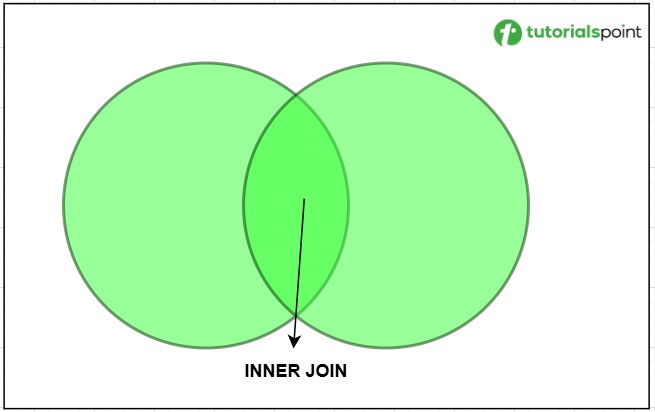
Syntax
Following is the syntax of INNER JOIN −
SELECT table1.column1, table2.column2... FROM table1 INNER JOIN table2 ON table1.common_filed = table2.common_field;
Based on the above tables, we can write an INNER JOIN as follows −
testdb=# SELECT EMP_ID, NAME, DEPT FROM COMPANY INNER JOIN DEPARTMENT
ON COMPANY.ID = DEPARTMENT.EMP_ID;
The above given query will produce the following result −
| emp_id | name | dept |
|---|---|---|
| 1 | Paul | IT Billing |
| 2 | Allen | Engineering |
The LEFT JOIN
The LEFT JOIN is also known as LEFT OUTER JOIN. It is an extension of the INNER JOIN. SQL standard defines three types of OUTER JOINs: LEFT, RIGHT, and FULL and PostgreSQL supports all of these.
In case of LEFT OUTER JOIN, an inner join is performed first. Then, for each row in table T1 that does not satisfy the join condition with any row in table T2, a joined row is added with null values in columns of T2. Thus, the joined table always has at least one row for each row in T1.
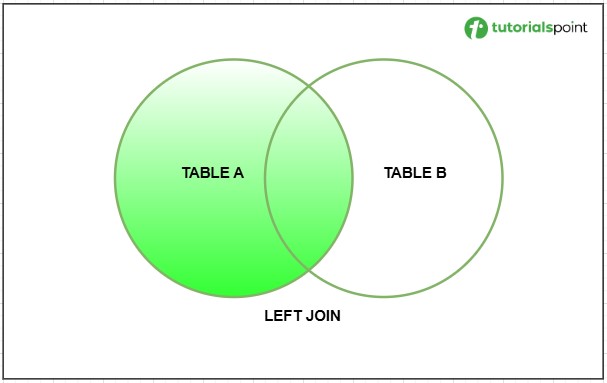
Syntax
Following is the syntax of LEFT OUTER JOIN −
SELECT ... FROM table1 LEFT OUTER JOIN table2 ON conditional_expression ...
Based on the above tables, we can write an inner join as follows −
testdb=# SELECT EMP_ID, NAME, DEPT FROM COMPANY LEFT OUTER JOIN DEPARTMENT ON COMPANY.ID = DEPARTMENT.EMP_ID;
The above given query will produce the following result −
| emp_id | name | dept |
|---|---|---|
| 1 | Paul | IT Billing |
| 2 | Allen | Engineering |
| James | ||
| David | ||
| Paul | ||
| Mark | ||
| Teddy | ||
| James |
The RIGHT JOIN
The RIGHT JOIN is also known as RIGHT OUTER JOIN. First, an inner join is performed. Then, for each row in table T2 that does not satisfy the join condition with any row in table T1, a joined row is added with null values in columns of T1. This is the converse of a left join; the result table will always have a row for each row in T2.
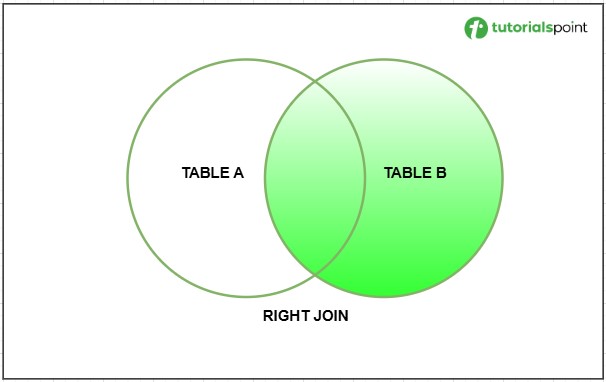
Syntax
Following is the syntax of RIGHT OUTER JOIN −
SELECT ... FROM table1 RIGHT OUTER JOIN table2 ON conditional_expression ...
Based on the above tables, we can write an inner join as follows −
testdb=# SELECT EMP_ID, NAME, DEPT FROM COMPANY RIGHT OUTER JOIN DEPARTMENT ON COMPANY.ID = DEPARTMENT.EMP_ID;
The above given query will produce the following result −
| emp_id | name | dept |
|---|---|---|
| 1 | Paul | IT Billing |
| 2 | Allen | Engineering |
| 7 | Finance |
The FULL OUTER JOIN
First, an inner join is performed. Then, for each row in table T1 that does not satisfy the join condition with any row in table T2, a joined row is added with null values in columns of T2. In addition, for each row of T2 that does not satisfy the join condition with any row in T1, a joined row with null values in the columns of T1 is added.
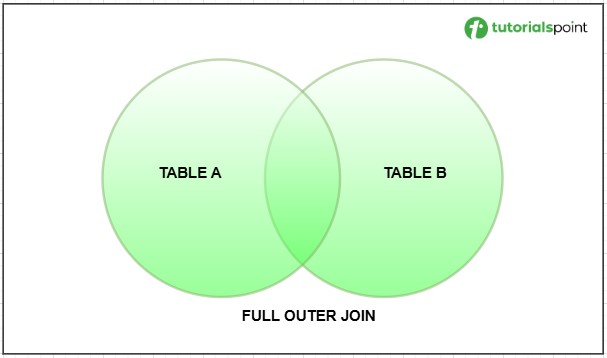
Syntax
Following is the syntax of PostgreSQL FULL OUTER JOIN −
SELECT ... FROM table1 FULL OUTER JOIN table2 ON conditional_expression ...
Based on the above tables, we can write an inner join as follows −
testdb=# SELECT EMP_ID, NAME, DEPT FROM COMPANY FULL OUTER JOIN DEPARTMENT ON COMPANY.ID = DEPARTMENT.EMP_ID;
The above given query will produce the following result −
| emp_id | name | dept |
|---|---|---|
| 1 | Paul | IT Billing |
| 2 | Allen | Engineering |
| 7 | Finance | |
| James | ||
| David | ||
| Paul | ||
| Mark | ||
| Teddy | ||
| James |
The CROSS JOIN
A CROSS JOIN matches every row of the first table with every row of the second table. If the input tables have x and y columns, respectively, the resulting table will have x+y columns. Because CROSS JOINs have the potential to generate extremely large tables, care must be taken to use them only when appropriate.
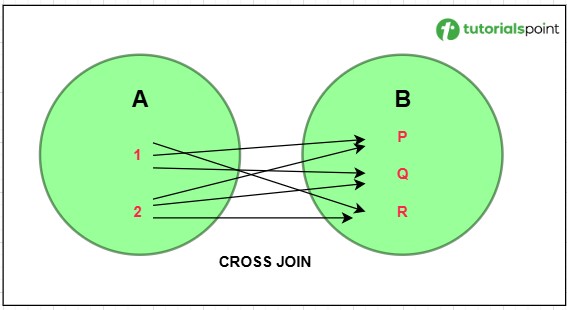
Syntax
Following is the syntax of PostgreSQL CROSS JOIN −
SELECT ... FROM table1 CROSS JOIN table2 ...
Based on the above tables, we can write a CROSS JOIN as follows −
testdb=# SELECT EMP_ID, NAME, DEPT FROM COMPANY CROSS JOIN DEPARTMENT;
The above given query will produce the following result −
| emp_id | name | dept |
|---|---|---|
| 1 | Paul | IT Billing |
| 1 | Teddy | IT Billing |
| 1 | Mark | IT Billing |
| 1 | David | IT Billing |
| 1 | Allen | IT Billing |
| 1 | Paul | IT Billing |
| 1 | James | IT Billing |
| 1 | James | IT Billing |
| 2 | Paul | Engineering |
| 2 | Teddy | Engineering |
| 2 | Mark | Engineering |
| 2 | David | Engineering |
| 2 | Allen | Engineering |
| 2 | Paul | Engineering |
| 2 | James | Engineering |
| 2 | James | Engineering |
| 7 | Paul | Finance |
| 7 | Teddy | Finance |
| 7 | Mark | Finance |
| 7 | David | Finance |
| 7 | Allen | Finance |
| 7 | Paul | Finance |
| 7 | James | Finance |
| 7 | James | Finance |
The SELF JOIN
In PostgreSQL, a SELF JOIN is a type of join operation where a table joins itself.

Syntax
Following is the syntax of PostgreSQL SELF JOIN is as follows −
SELECT A.column_name, B.column_name FROM table_name A JOIN table_name B ON A.common_column = B.common_column;
Based upon the above query, we can write the query of SELF JOIN as follows −
SELECT A.id AS Emp1_ID, A.name AS Emp1_Name,
B.id AS Emp2_ID, B.name AS Emp2_Name,
A.address
FROM COMPANY A
JOIN COMPANY B
ON A.address = B.address
AND A.id B.id;
The above query obtained the following result −
| Emp1_ID | Emp1_Name | Emp2_ID | Emp2_Name | Address |
|---|---|---|---|---|
| 5 | David | 2 | Allen | Texas |
| 2 | Allen | 5 | David | Texas |
| 9 | James | 3 | Teddy | Norway |
| 3 | Teddy | 9 | James | Norway |
The NATURAL JOIN
In PostgreSQL, NATURAL JOIN is a type of join that combines two or more tables based on a common column with the same name and data type.
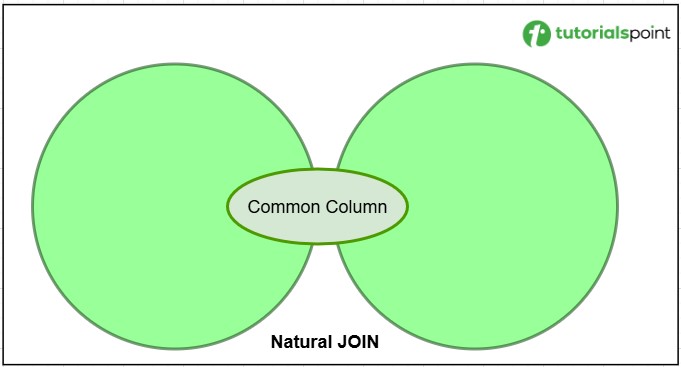
Syntax
Following is the syntax of PostgreSQL SELF JOIN is as follows −
SELECT * FROM table1 NATURAL JOIN table2;
Based upon the intial table of this chapter, we write the query of NATURAL JOIN as follows −
SELECT * FROM COMPANY NATURAL JOIN DEPARTMENT;
The above query obtained the following result −
| id | name | age | address | salary | join_date | dept | emp_id |
|---|---|---|---|---|---|---|---|
| 1 | Paul | 32 | California | 20000 | 2001-07-13 | IT Billing | 1 |
| 2 | Allen | 25 | Texas | 2007-12-13 | Engineering | 2 |